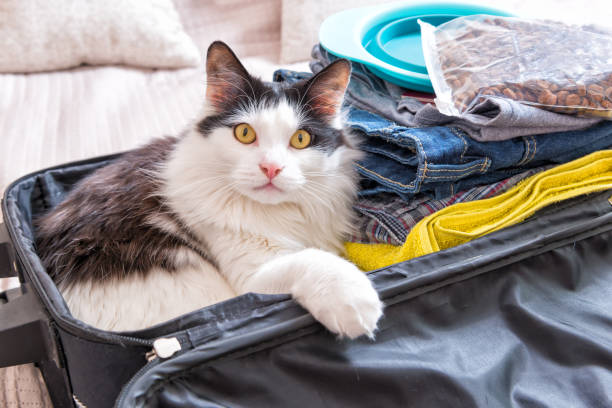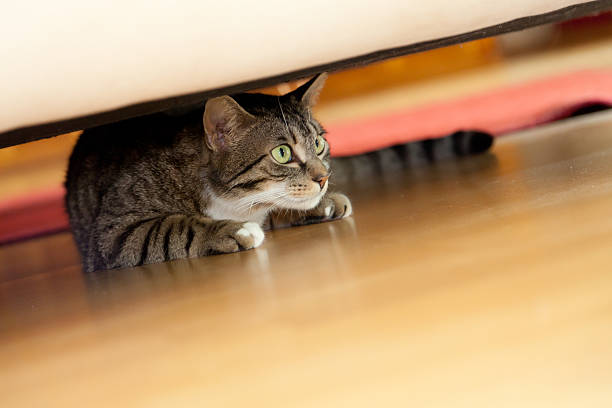Well, hello there, fellow cat owners! We all adore those moments of togetherness with our purr-fect friends, don’t we? But sometimes, those car rides together can make travel a true cat-astrophe! You’ve probably noticed it: the excessive meowing, the restlessness, and perhaps even some physical discomfort. What you’ve got on your hands is a case of ‘cat travel anxiety’. But don’t worry, in this blog post, we’re going to tackle it paw by paw, and make sure the next journey you and your kitty embark on is as smooth as a cat’s purr.
Ready to buckle up and dive right in? Keep reading for everything you need to know about anxiety in cats.
Table of Contents
Signs of cat travel anxiety
Before you can fix a problem, you need to know it’s there, right? So, let’s get to know our cats a bit better. Contrary to what they’d like us to believe, cats are creatures of habit and routine. That cozy corner by the window? That’s their comfort zone. A moving car, on the other hand, can be a big, scary world for them. Here are the tell-tale signs that your kitty may be wrestling with travel anxiety:
Excessive Meowing
Cats express discomfort and stress in various ways, and one of the most common is through vocalization. Excessive meowing or yowling during a car ride may signal travel anxiety.
Agitation
Does your cat seem unusually restless? Are they pacing in their carrier, unable to sit still? This could be a sign of travel-related stress.
Behavioral Changes
Any deviation from your cat’s normal behavior should be a red flag. If they suddenly start over-grooming, exhibit aggression, or show signs of withdrawal, they might be experiencing anxiety.
Physical Discomfort
In extreme cases, symptoms like vomiting, drooling or diarrhea could be a signal of cat motion sickness exacerbated by anxiety.
Remember, you know your feline friend best. If they’re acting out of character, it’s possible they’re trying to communicate their discomfort.
How to reduce feline travel stress
Now that we know what cat travel anxiety looks like, let’s get proactive! Here are some nifty tricks you can employ to ease your kitty into becoming a more comfortable traveler:
Gradual Acclimatization
This involves exposing your cat to travel conditions gradually. Start by taking them on short car rides around the block, and slowly increase the duration of the trips. This helps them get accustomed to the vehicle and movement.
Comfort Objects
Cats find comfort in familiarity. Bringing along their favorite blanket or toy can make them feel safe and secure. You could also add a piece of your clothing – the scent can have a calming effect.
Pheromones
Products that mimic feline facial pheromones can create a sense of safety and familiarity for your cat. These are available as sprays, diffusers, and even collars.
Regular Breaks
If you’re on a long journey, make sure to stop regularly. This gives your cat a chance to use the litter box, eat, drink, and stretch their legs. Feeding your cat on time during the car trips also helps in reducing their anxiety.
Secure Cat Carrier
Choose a well-ventilated, secure carrier for your cat. Make it a positive place for your cat by adding comfortable bedding and treating it with pheromones. Reward your cat for going into the carrier. However, if she is not comfortable in the carrier, simply take the cat our of the carrier.
While these strategies can significantly reduce the likelihood of travel anxiety, remember that each cat is unique. What works for one might not work for another. Experiment with different methods and see what suits your cat best.

What To Do If My Cat Has Travel Anxiety?
Despite your best preventive measures, some cats might still develop travel anxiety. In such cases, there are several steps you can take:
Anti-anxiety Medication
If you notice persistent signs of travel anxiety in your cat, consult your veterinarian. They might prescribe anti-anxiety medication or recommend a sedative for travel, depending on your cat’s specific needs and the severity of their anxiety.
Homeopathic Remedies
There are homeopathic remedies available, such as HomeoPet Travel Anxiety drops, which may help alleviate your cat’s travel anxiety. However, always ask your veterinarian before introducing any new treatments to your cat’s routine and monitor your cat closely after every new medication.
Calm Down Your Cat Through Reassurance
Sometimes, all your cat needs is a little reassurance. Speaking softly, petting them gently, or singing to them can provide comfort and help calm them down.
While dealing with a travel-anxious cat can be stressful, remember that they’re not acting out of disobedience – they’re genuinely afraid. Empathy, patience, and a gentle approach can go a long way in reassuring an anxious cat.
What to Avoid When My Travel Cat Is Anxious During the Travel?
Responding correctly to a cat with travel anxiety is crucial. Here’s what you should avoid doing when your feline friend is showing signs of anxiety:
Forcing Interaction
If your cat wants to hide in their carrier or retreats to a corner, don’t force interaction. Let them have their space – it’s one of the ways they cope with their fear.
Punishment
Never punish your cat for displaying anxiety symptoms. This can exacerbate their fear and make their anxiety worse in the long run.
Neglecting Hydration
Travel can be dehydrating, especially for an anxious cat. Ensure your cat has regular access to fresh water throughout the journey.
Ignoring Persistent Symptoms
If your cat’s anxiety symptoms persist despite your efforts, talk to your veterinarian. Ignoring persistent symptoms can lead to long-term trauma and health issues.
Managing cat travel anxiety can be challenging, but with patience and the right approach, it’s possible to reduce your cat’s stress and ensure a smoother travel experience.

Wrapping It Up: Turning Cat Travel Anxiety Into a Purrfect Journey
Cat travel anxiety can be a hurdle, but with a little understanding and the right approach, you and your feline friend can journey together with ease. Remember, in the face of the unfamiliar, your cat looks to you for comfort and reassurance. With your patience, empathy, and proactive steps, you can help your cat overcome their fears and turn every journey into a happy memory.
So, as you plan your next adventure together, keep these tips in mind. With a little preparation and lots of love, you can help transform travel from a source of anxiety into an exciting experience for your furry friend.
Fasten your seat belts, smooth rides are ahead. Safe travels and paw-some journeys to you and your feline companion!
Stress-free travel with your cat – Frequently Asked Questions
Q: What is cat travel anxiety?
A: Cat travel anxiety is a phenomenon where a cat experiences stress and fear due to unfamiliar environments and experiences associated with travel, such as movement and confinement.
Q: How do I know if my cat has travel anxiety?
A: Signs of cat travel anxiety can include excessive vocalization, restlessness, behavioral changes, and physical discomfort such as vomiting or diarrhea.
Q: How can I prevent travel anxiety in my cat?
A: Preventive measures can include gradual acclimatization to travel, providing comfort objects during the journey, using feline facial pheromones, taking regular breaks during long trips, and using a secure carrier.
Q: What should I do if my cat is anxious during travel?
A: If your cat displays signs of travel anxiety, try reassuring them with gentle words and petting, and consider consulting a veterinarian for possible anti-anxiety medication or sedatives. Homeopathic remedies may also be an option.
Q: What should I avoid doing when my cat is anxious during travel?
A: Avoid forcing interaction, punishing your cat for their anxiety symptoms, neglecting hydration, and ignoring persistent symptoms.
Q: How can I help my cat overcome travel anxiety?
A: You can help your cat overcome travel anxiety by gradually introducing them to the carrier, using pheromone products like Feliway, and speaking with your veterinarian about potential sedative options.
Q: What are some common cat sedatives for travel?
A: Some common cat sedatives for travel include HomeoPet Travel Anxiety, as well as prescription medications that can be provided by your veterinarian.
Q: How can I train my cat to be more comfortable with car travel?
A: You can train your cat to be more comfortable with car travel by taking short, positive trips, offering treats and reassurance, and creating a calming environment within the carrier.
Q: Is it advisable to give my cat a sedative for travel?
A: It’s advisable to speak with your veterinarian about the possibility of giving your cat a sedative for travel, especially if they experience extreme anxiety or stress during car travel.
Q: What should I do to keep my cat calm during travel?
A: To keep your cat calm during travel, you can use any pheromone products prescribed by the vet, provide a familiar blanket or toy in the carrier, and keep the environment as quiet and stress-free as possible.